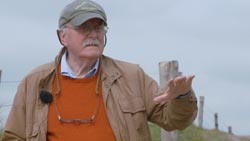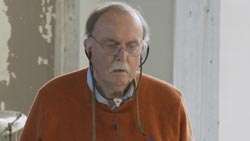| Bird and Person Dyning (1975) “… and I heard ‘heterodyning’ – difference between the two frequencies – between the pitches of the feedback and the bird call. It was fascinating, seemed to happen in my ears.”  Reading the title one may think: “Is there a misprint?”,“Is this an old form of ‘dining’?” No, it is not. “Dyning” is Lucier’s abbreviated version of “heterodyning,” a term introduced in the early days of radio transmission. It describes the phenomenon that if two waves are mixed (in a non-linear medium) two extra signals are created with the sum and difference in frequency. This phenomenon can also occur when sound waves reach our ear, with the exception that in the ear mainly “difference tones” are produced.
The task of the performer in this piece is to create difference tones (let’s call them “phantoms”) with the following two sound sources: First, there is an electric bird call (originally a Christmas ornament producing the chirping sound), and, second, there is a feedback created by a binaural microphone and a stereo system. Only at certain frequencies of the feedback will the phantoms appear. Since the frequencies depend on the position of the performer in the space, the performer has to change and control the frequency of the feedback by moving in the space or changing the position of his head.
“…BIRD AND PERSON DYNING is here noted as a landmark because it is, uniquely, music where we actually listen to a composer listening. The sweet joke of the title conveys some of the intimacy of the piece: on stage are found only a solo performer wearing binaural mics, an electronic bird call hidden in a Christmas ornament, and a couple of loud speakers. The only visible motion is that of the performer, carefully moving through the space, sometimes walking, sometimes making just the slightest move of the head (listening and moving are here inseparable). The sounds heard are that bird call, and that bird call as heard by the performer through the binaural mics and the loudspeakers, and the increasing interactions between the two. Like all intimate situations, this simple one can rapidly, no catastrophically, turn into a complex one.”
Since the phantoms are mainly, if not exclusively, created in our ear, they can hardly be recorded. They either reoccur in the playback situation or could be captured should heterodyning exceptionally take place in the electronic devices of the playback or recording systems. In any case, we were quite happy that at least some phantoms are audible in our sequence, especially in the concert part. | | THE FILM 
DESCRIPTION OF PIECES 
NEXT 
OVERVIEW 
DIRECTORS 
ALVIN LUCIER 
TRAILER 
CREDITS 
NEWS 
CONTACT 
| |








